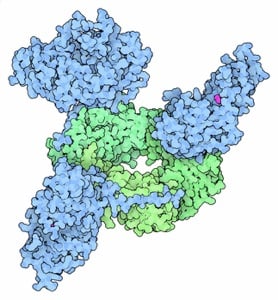Action of Enzymes on Sliding Clamps
Once the clamp is loaded onto DNA, it acts as a sliding platform for the action of scores of enzymes and other proteins to scan and act on DNA. The clamp acts as a central hub to organize the activities of enzymes in the various cellular pathways of DNA replication, DNA repair, cell cycle control, chromatin structure and apoptosis.
However, how these various activities are coordinated spatially and temporally is unknown. We want to know the cellular, molecular and structural determinants for this coordination.

|
Human Fen1 (blue) in complex with the sliding clamp (green) |
The Kelch Lab has recently discovered how a hypomorphic disease-causing mutation in the human sliding clamp causes specific perturbations to a subset of clamp-binding partners (see Duffy et al JMB 2016). More recently, we reported the discovery of another mutation that results in PCNA-Associated DNA Repair Disorder (Magrino et al JBC 2022; see story in ASBMB Today here). Our multi-disciplinary studies have revealed that both mutations cause a stability defect in PCNA, and that this stability defect may be the molecular basis for disease.

